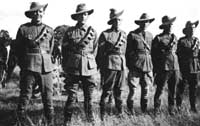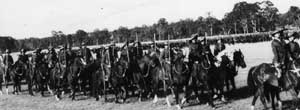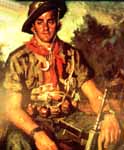 |
|
|||
|
|
||||
|
6th Australian Light Horse Regiment |
|
2/6th Armoured Regiment, Royal NSW Regiment |
The origins of the 6th Light Horse Regiment can be traced back to the 11th of September 1888, when 1 Captain, 1 Sergeant and 30 Troopers were sworn in at Victoria Barracks, Sydney. Previous to that, some advertising was done and those 32 positions were quickly filled. The original Commanding Officer was Captain Henry Glendower Bodysham Sparrow. The original horses for the unit were bought from Neersfield Station near Singleton, New South Wales. In January 1889, the unit was extended to include Companies at Queanbeyan, Picton, Campbelltown and Inverell, Campbelltown being their headquarters. The badge was the crossed rifles with a wreath of Waratahs and a Queens crown with a lion rampant. They served with distinction during their tour of duty, taking part in the Relief of Kimberly under the column commanded by General Sir John French and fought in the battles of Wittenbergen and Diamond Hill. The Kings Colour was presented to the Regiment by the Governor General of Australia in Melbourne in November of 1904, the colour party consisted of three distinguished soldiers who had fought in the Boer War - Colonel J. W. MacArthur-Onslow, Captain R. C. Holman* DSO, DCM and the colour was carried by Regimental Quarter Master Sergeant Wardrow. On
the 1st of July 1912, Capt G. M MacArthur-Onslow, also a Boer War
veteran, took command for a period of two years, he later commanded
the 5th Light Horse Brigade and received the honours CMG, DSO, Order
of the Nile. After training, they landed at Gallipoli on the 20th of May 1915. The regiments distinguished service on Gallipoli and in the Middle East is well recorded. Shrapnel Gully, Johnsons, Jolly, Romani, Amnan, Es Salt, Beersheba, Gaza, Meggido, the Jordan Valley. At Romani it was the first time that they had served together as a complete mounted Regiment and, along with other Light Horse units, took over 11,000 prisoners. On the 28th of June 1919, a total of 15 officers and 391 other ranks sailed for home after having been detained since the previous December due to their policing duties during the Egyptian Rebellion, finally arriving in Sydney on the 3rd of August 1919. The command at this time fell to Major D.G. Cross, Lt Colonel C.D. Fuller DSO - Order of the Nile, having taken temporary command of the 2nd Light Horse Brigade. During the Regiments almost five years on active service, it received 5 DSOs, 5 MCs, 6 DCMs, 13 MMs and was awarded 5 foreign decorations. The Regiment suffered 134 deaths either killed in action or died of wounds, etc. had 461 wounded in action, 1265 were evacuated through illness and had 16 taken prisoner of war. In 1928, during a review of the 4th Cavalry Brigade at Liverpool on Sydney's outskirts, the Guidon with battle honours emblazoned was presented to the 6th Light Horse Regiment New South Wales Mounted Rifles by Lt General Sir Harry Chauvel GCMG, KCB. Croix de Guerre (France) the Guidon party once again consisted of some distinguished soldiers, Major C. M. Featherstonhaugh DSO, a Boer War veteran, Lt R. Blake, who carried the Guidon and Major F. B. Hinton DSO. In 1930 the 6th Light Horse was reformed once again to include parts of the central west with the headquarters at Orange during this period as CMF or Militia, as it was known. The Regiment once again maintained a distinguished record until it was demobilised and became the 6th Motorised Regiment and part of the 1st Armoured Division in December of 1941. In 1934 the Parkes troop of the 6th Light Horse had won the Prince of Wales Cup, they also fielded a reasonable polo team, members of the troop also competed in the King's Shoot, at that time Australia's premier military shooting competition. Several members rose to prominent positions before, during and after the war. From the ranks of the Regiment came Sir Colin Hines, former State President of the NSW Returned Services League, Sir Marcus Loane, former Anglican Primate of Australia, Colonel Eric Hennessy was a sergeant in the Orange troop between the wars, was a member of the Australian Contingent for the Coronation of King George the 6th in 1937 and did guard duty at Buckingham Palace, a unique honour. He later became CO of the 2/6th Independent Company during the Second World War. A former administrator of the Northern Territory, John England also served in the Regiment. Bruce LeStrange of Condobolin, who won the Military Medal while serving with the 2/7th Independent Co in New Guinea as a sergeant, joined the Regt as a 17 year old. Bruce also served with the Occupation Forces in Japan and had the distinction of leading the Victory Contingent in London after the war, a painting of Bruce simply entitled Slugger now hangs in the Australian War Memorial, Canberra. In 1948, the CMF was reformed. The unit became the 2/6th Armoured Regt, part of the 1st Armoured Brigade under the command of Lt Col W. A. Ormiston, with the HQ at Orange. In 1953 the command fell to Lt Col Costello and then, in 1956, due to reorganisation, its long role as a mounted unit was terminated. It was reorganised as an Infantry Battalion and became part of the 8th Infantry Brigade under Lt Col J. G. Wylie E.D. On the 1st July 1959, Lt Col C. B. Cutler became CO, in 1960, its role as an Infantry Btn was terminated and was downgraded to a mounted rifle company of the Royal New South Wales Regiment with its Headquarters at Orange and platoons at Bathurst, Dubbo and Parkes. This page has details copied from the active website at http://www.lighthorse.org.au/default.htm |



